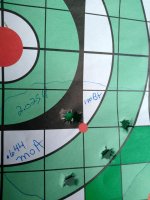kilotanker22
New member
Here is a range update on my TC Venture 270 WSM. Pretty sure I am gonna keep this load for this rifle.
This is the Nosler 140 grain ballistic tip, with 67.5 Grains of Magpro. Seated .030 off the lands at a COAL of 2.744. CCI 250 LRM primers.
The first target is 200 yards 5 round group. the third round I pulled and ruined the group. So I measured the group without that shot. so 4 shot group was 1.311" , so .626 MOA.
Second photo is 300 yards. 5 shots. 2.025" or .644 MOA.
I am impressed with this rifle. I have a 3-9 power Nikon on top so nothing special.
At the moment I do not have a chronograph so I am gonna try to figure velocity by the elevation difference from 200-300 yards. (The range I was at today only goes to 300. At 200 yards The center of my group is approximately 2.75" high. At 300 yards the center of my group is 2.5 inches low. That is without adjusting the elevation on the optic. Now I have got to figure out what velocity numbers would make that bullets trajectory... I will compare it to a new chronograph in a couple weeks.
Anyone care to make a guess at the velocity?
This is the Nosler 140 grain ballistic tip, with 67.5 Grains of Magpro. Seated .030 off the lands at a COAL of 2.744. CCI 250 LRM primers.
The first target is 200 yards 5 round group. the third round I pulled and ruined the group. So I measured the group without that shot. so 4 shot group was 1.311" , so .626 MOA.
Second photo is 300 yards. 5 shots. 2.025" or .644 MOA.
I am impressed with this rifle. I have a 3-9 power Nikon on top so nothing special.
At the moment I do not have a chronograph so I am gonna try to figure velocity by the elevation difference from 200-300 yards. (The range I was at today only goes to 300. At 200 yards The center of my group is approximately 2.75" high. At 300 yards the center of my group is 2.5 inches low. That is without adjusting the elevation on the optic. Now I have got to figure out what velocity numbers would make that bullets trajectory... I will compare it to a new chronograph in a couple weeks.
Anyone care to make a guess at the velocity?
Attachments
Last edited:


